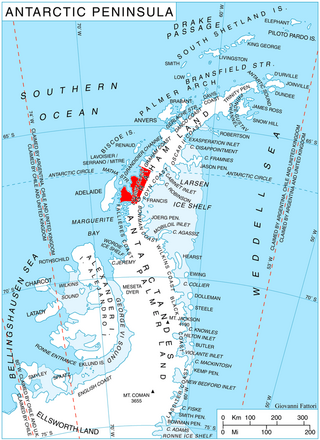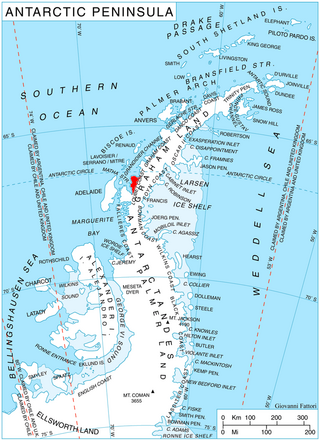Related Research Articles

Arrowsmith Peninsula is a cape about 40 miles (64 km) long on the west coast of Graham Land, west of Forel Glacier, Sharp Glacier and Lallemand Fjord, and northwest of Bourgeois Fjord, with Hanusse Bay lying to the northwest. It was surveyed by the Falkland Islands Dependencies Survey (FIDS) in 1955-58 and named for Edwin Porter Arrowsmith, Governor of the Falkland Islands.

Shiver Point is a point, surmounted by a peak 670 cm high, 8 miles (13 km) west of Cape Fairweather on the east coast of Graham Land, Antarctica forming the west side of the entrance to Artanes Bay and the northeast side of the entrance to Vaughan Inlet.
Index Peak is a peak over 1,220 metres (4,000 ft) high, standing 7.5 miles (12 km) southeast of Cape Garcia on the west coast of Graham Land, Antarctica. It was mapped by the Falkland Islands Dependencies Survey from photos taken by Hunting Aerosurveys Ltd in 1956–57, and so named by the UK Antarctic Place-Names Committee because the peak resembles an index finger.
Mount Ariel is a peak, 1,250 m, marking the south limit of Planet Heights and overlooking the north side of Uranus Glacier in the east part of Alexander Island. The peak lies 3 miles (5 km) east of Atoll Nunataks Probably first seen by Lincoln Ellsworth, who flew directly over it and photographed segments of this coast on November 23, 1935. First mapped from air photos taken by the Ronne Antarctic Research Expedition (RARE), 1947–48, by Searle of the Falkland Islands Dependencies Survey (FIDS) in 1960. So named by the United Kingdom Antarctic Place-Names Committee (UK-APC) because of its association with Uranus Glacier, Ariel being one of the satellites of Uranus.
Börgen Bay is a bay 4 nautical miles (7 km) wide, indenting the southeast coast of Anvers Island in the Palmer Archipelago of Antarctica. Canty Point marks the west side of the entrance to Börgen Bay, while Bay Point marks the east entrance. Billie Peak stands 1.5 nautical miles (3 km) east-northeast of Bay Point.

Owlshead Peak is a peak 1.5 nautical miles (2.8 km) east of Cape Bellue on Stresher Peninsula on the west coast of Graham Land. Photographed by the Falkland Islands and Dependencies Aerial Survey Expedition (FIDASE) in 1956–57, and roughly surveyed by the Falkland Islands Dependencies Survey FIDS from "Detaille Island", 1956-59. The name is descriptive of the feature when seen from Crystal Sound and Darbel Bay.
Voit Peak is a peak between Drummond and Hopkins Glaciers on the west coast of Graham Land. Photographed by the Falkland Islands and Dependencies Aerial Survey Expedition (FIDASE) in 1956–57. Named by the United Kingdom Antarctic Place-Names Committee (UK-APC) in 1960 for Carl von Voit (1831–1908), German physiologist, pioneer of basic metabolic studies who published what was probably the first standard of human calorie requirements in 1881.
The Cragsman Peaks are peaks on the west side of Marshall Bay, extending from Cape Vik northwest to Coldblow Col on the south coast of Coronation Island, in the South Orkney Islands. They were surveyed by the Falkland Islands Dependencies Survey in 1956–58 and so named by the UK Antarctic Place-Names Committee because the peaks provide a "climbers' paradise."
Jeffries Peak is a peak standing southward of Wilhelmina Bay, between Leonardo Glacier and Blanchard Glacier on the west coast of Graham Land, Antarctica. It was mapped by the Falkland Islands Dependencies Survey from photos taken by Hunting Aerosurveys Ltd in 1956–57, and was named by the UK Antarctic Place-Names Committee for John Jeffries, an American physician who, with Jean Blanchard, made the first balloon crossing of the English Channel in 1785.

Demorest Glacier is a glacier on the northeast side of Hemimont Plateau which flows southeast into Whirlwind Inlet between Flint Glacier and Matthes Glacier, on the east coast of Graham Land. It was discovered by Sir Hubert Wilkins on a flight of December 20, 1928, and photographed from the air by the United States Antarctic Service in 1940. It was charted by the Falkland Islands Dependencies Survey in 1947 and named for Max H. Demorest, an American glaciologist.

Drummond Glacier is a glacier 10 nautical miles (18 km) long and 2 nautical miles (4 km) wide, on the west coast of Graham Land, situated south of Hopkins Glacier and flowing west-northwest between Voit Peak and Sherba Ridge into Darbel Bay east of Sokol Point.
Erskine Glacier is a glacier 16 nautical miles (30 km) long on the west coast of Graham Land, flowing west into Darbel Bay to the north of Hopkins Glacier. It was first surveyed by the Falkland Islands Dependencies Survey (FIDS) in 1946–47, and named "West Gould Glacier". With East Gould Glacier it was reported to fill a transverse depression across Graham Land, but further survey in 1957 showed no close topographical alignment between the two. The name Gould has been limited to the east glacier and an entirely new name, for Angus B. Erskine, leader of the first FIDS party to travel down the glacier and to survey it in detail, has been approved for the west glacier.
Flinders Peak is a conspicuous triangular peak, 960 metres (3,150 ft) high, on the west end of the Bristly Peaks. The peak overlooks Forster Ice Piedmont near the west coast of the Antarctic Peninsula. It was photographed from the air by the British Graham Land Expedition and the Ronne Antarctic Research Expedition. It was surveyed from the ground by the Falkland Islands Dependencies Survey in December 1958, and was named by the UK Antarctic Place-Names Committee after Matthew Flinders, an English navigator who discovered the cause of deviation in magnetic compasses, and pointed the way to a solution, 1805–14.
The McConnel Islands are islands lying in Darbel Bay southeast of the Kidd Islands, off the west coast of Graham Land, Antarctica. They were photographed by the Falkland Islands and Dependencies Aerial Survey Expedition, 1956–57, and were named by the UK Antarctic Place-Names Committee in 1960 for James C. McConnel (1860–1890), an English physicist who, along with Dudley Kidd, made pioneer experiments on the plastic deformation of ice, both single and polycrystals, 1881–90.
Matthes Glacier is a glacier 9 nautical miles (17 km) long, flowing east into Whirlwind Inlet between Demorest Glacier and Chamberlin Glacier, on the east coast of Graham Land, Antarctica. It was discovered by Sir Hubert Wilkins on a flight of December 20, 1928, and photographed from the air by the United States Antarctic Service in 1940. It was charted by the Falkland Islands Dependencies Survey in 1947 and named for François E. Matthes, then chief geologist with the U.S. Geological Survey.

McCance Glacier is the 30-km long and 5 km wide glacier draining the Hutchison Hill area on the west slopes of Avery Plateau on Loubet Coast in Graham Land, Antarctica. It flows north-northwestwards along the west side of Osikovo Ridge, Kladnitsa Peak and Rubner Peak and enters Darbel Bay.

Mapple Glacier is a narrow glacier 15 nautical miles (28 km) long, flowing eastward between Arkovna Ridge and Stevrek Ridge in the Aristotle Mountains of Antarctica to enter Sexaginta Prista Bay on the east side of Graham Land. It lies 2 nautical miles (4 km) north of Melville Glacier and is separated from it by a line of small peaks. The glacier was surveyed by the Falkland Islands Dependencies Survey in 1961, and was named by the UK Antarctic Place-Names Committee after Father Mapple, the whalemen's Nantucket priest in Herman Melville's Moby-Dick.
Houser Peak is a peak, 1,080 metres (3,540 ft) high, between Tofani Glacier and Franca Glacier at the head of Solberg Inlet, Bowman Coast, Antarctica. The peak was photographed from the air by the United States Antarctic Service, 1940, the U.S. Navy, 1966, and was surveyed by the Falkland Islands Dependencies Survey, 1946–48. It was named by the Advisory Committee on Antarctic Names in 1977 for Elaine Houser, an administrative officer with Holmes and Narver, Inc., which from the 1968–69 season through 1979–80, provided engineering, construction, and general support services to United States Antarctic Research Program stations in Antarctica.

Lens Peak is a peak at the south side of Holtedahl Bay just east of Conway Island, on the northeast coast of Stresher Peninsula on the west coast of Graham Land, Antarctica. It was photographed by Hunting Aerosurveys Ltd in 1956–57, and mapped from these photos by the Falkland Islands Dependencies Survey. The peak was named by the UK Antarctic Place-Names Committee in 1960 from association with a group of features in the area commemorating pioneers of research on snow blindness and the design of snow goggles.

Lewis Glacier is the northerly of two glaciers flowing from Hemimont Plateau east into Seligman Inlet, on the east coast of Graham Land, Antarctica. The glacier was photographed from the air by the United States Antarctic Service in 1940. It was charted in 1947 by the Falkland Islands Dependencies Survey, who named it for British glaciologist William Vaughan Lewis, a lecturer at the Department of Geography, Cambridge University.
References
- ↑ "Greenshields Peak". Geographic Names Information System . United States Geological Survey, United States Department of the Interior . Retrieved 2012-05-07.
![]() This article incorporates public domain material from "Greenshields Peak". Geographic Names Information System . United States Geological Survey.
This article incorporates public domain material from "Greenshields Peak". Geographic Names Information System . United States Geological Survey.